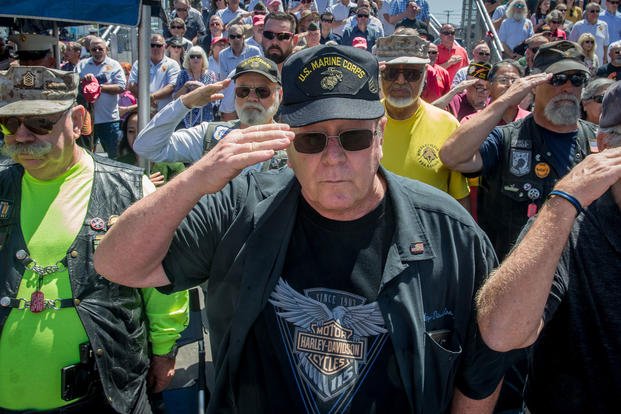Veterans Day started out as Armistice Day, a way to mark the end of World War I when the fighting stopped on November 11, 1918. It was originally a day to remember those who served in that war, but after World War II and the Korean War, the U.S. decided to honor all veterans instead of just one group.
In 1954, it officially became Veterans Day. The day is about honoring everyone who has served — past and present — and thanking them for the courage, sacrifice and dedication they’ve shown in protecting the country.
What Is Veterans Day?
Veterans Day gives Americans the opportunity to celebrate the bravery and sacrifice of all U.S. veterans. However, most Americans confuse this holiday with Memorial Day, according to the Department of Veterans Affairs.What's more, some Americans don't know why we commemorate our veterans on November 11. It's imperative that all Americans know the history of Veterans Day so that we can honor our former service members properly.
Memorial Day honors service members who died in service to their country or as a result of injuries incurred during battle. Deceased veterans are also remembered on Veterans Day, but the difference is that Veterans Day is set aside to thank and honor living veterans who served honorably in the military, whether in wartime or peacetime.
Related:
- Veterans Day Free Meals and Restaurant Deals and Discounts
- Veterans Day Freebies, Deals and Discounts
History of Veterans Day
In 1938, Armistice Day was established to remember the armistice – or agreement – that had been signed back on November 11, 1918, marking the end of WWI. President Woodrow Wilson proclaimed the first Armistice Day in 1919, emphasizing peace and honoring those who served in the Great War.
In 1938, Armistice Day was declared a federal holiday with a focus on WWI veterans. In that legislation, the date of November 11 was "dedicated to the cause of world peace and to be hereafter celebrated and known as 'Armistice Day.'"
Armistice Day to Veterans Day
“Armistice Day” became “Veterans Day” as the holiday evolved from commemorating the end of WWI to honoring all U.S. veterans.
In 1954, after the U.S. had gone through the devastation of World War II and the Korean War, the scope of the holiday broadened. At the urging of veterans service organizations, the 83rd U.S. Congress amended the Act of 1938 by replacing the word "Armistice" with "Veterans."
In his October 8, 1954, letter to the administrator of Veterans' Affairs, President Dwight Eisenhower wrote, “I have today signed a proclamation calling upon all of our citizens to observe Thursday, November 11, 1954 as Veterans Day. It is my earnest hope that all veterans, their organizations, and the entire citizenry will join hands to insure [sic] proper and widespread observance of this day.”
November 11 became Veterans Day, a day to honor American veterans of all wars.
Over the years, however, there were some changes to the actual date that Veterans Day was observed. In 1968, the Uniform Holiday Monday Act ensured three-day weekends for federal employees by celebrating four national holidays on Mondays: Washington's Birthday, Memorial Day, Veterans Day and Columbus Day.
Under this bill, Veterans Day was moved to the fourth Monday of October. The first Veterans Day under the new law was observed with much confusion on October 25, 1971. Many veterans as well as many members of the general public were not a fan of the date change. Many states also disagreed with this decision and continued to celebrate the holiday on its original date.
Finally on Sept. 20, 1975, President Gerald R. Ford signed a law that returned the annual observance of Veterans Day to November 11, beginning in 1978. This preserved the day’s historical significance.
Over the years, Veterans Day has evolved into a day not just for remembering those who served in wartime but also for recognizing all veterans, including those who served in peacetime. It now serves as a time to reflect on veterans' contributions and ongoing challenges, such as health care and employment. The day has become a platform for honoring service while also advocating for veterans' needs.
Key Events in Veterans Day History
In summary, Veterans Day, originally known as Armistice Day, began as a tribute to the end of WWI and has evolved into a day honoring all U.S. military veterans. Established in 1919 to commemorate the armistice signed on November 11, 1918, the holiday has undergone several changes, including being renamed Veterans Day in 1954 to honor veterans of all wars. Over time, it has grown into a day of national reflection, remembrance, and celebration of the contributions and sacrifices made by those who served in the U.S. armed forces.
- 1919: Armistice Day: The origins of Veterans Day lie in Armistice Day, which was first observed on November 11, 1919, to commemorate the first anniversary of the armistice that ended WWI.
- 1938: Federal Holiday: The U.S. Congress passed a law making Armistice Day a federal holiday, primarily honoring veterans of WWI and celebrating peace.
- 1947: First National Veterans Day Celebration: The first celebration that used the term "Veterans Day" was held after Raymond Weeks, a Navy veteran who served in WWII, organized a movement for a national day to honor all Americans who served in the armed forces. Weeks served as the director of the National Veterans Day Celebration in Birmingham, Alabama, for decades, until his death in 1985.
- 1954: Renaming to Veterans Day: After WWII and the Korean War, the holiday’s focus broadened to honor all American veterans. In 1954, President Eisenhower signed legislation officially changing the name from Armistice Day to Veterans Day to recognize veterans of all wars.
- 1968: The Uniform Monday Holiday Act: The law moved the celebration of Veterans Day to the fourth Monday in October to create more three-day weekends for federal employees. However, this change was unpopular.
- 1978: Return to November 11: Due to public and veterans' dissatisfaction with the date change, President Gerald Ford signed legislation in 1975 to restore Veterans Day to its original date of November 11, starting in 1978. The return acknowledged the historical significance of the WWI armistice.
Celebrating the Veterans Day Holiday
Veterans Day is celebrated across the U.S. with a variety of events to honor and recognize the service of military veterans.
National Veterans Day Ceremonies
Each year on November 11, there is a prominent Veterans Day ceremony at Arlington National Cemetery, where the president traditionally lays a wreath at the Tomb of the Unknown Soldier.
In addition, several other prominent national Veterans Day ceremonies take place across the United States, including:
- National World War II Memorial: Located in Washington, D.C., this memorial hosts an annual ceremony featuring speeches by dignitaries and veterans, as well as a wreath-laying event to honor those who served during World War II.
- Veterans Day National Ceremony: Also held at the U.S. Navy Memorial in Washington, D.C., this event includes the traditional reading of the names of veterans who have passed away in the last year, along with musical tributes and speeches.
- California's Veterans Day Ceremony: Held at the California State Capitol in Sacramento, this ceremony features a program that includes musical performances, speeches from state officials, and a wreath-laying ceremony to honor California veterans.
- The Vietnam Veterans Memorial: This memorial in Washington, D.C., hosts special ceremonies that often include the reading of names of fallen soldiers and other tributes to Vietnam veterans, emphasizing remembrance and reflection.
These ceremonies serve to honor and remember the sacrifices of veterans, providing opportunities for reflection.
Local Parades and Events
Additionally, communities large and small across the United States host parades, ceremonies, speeches, wreath-laying events, concerts, and military displays for Veterans Day. Organizations including schools often hold programs featuring veterans as guest speakers.
Read More: Veterans Day Parades, Events and More
Ways to Honor Veterans
In addition to parades and similar celebrations, families, individuals, and communities often take time to visit veterans' memorials, cemeteries, or spend personal moments with loved ones who have served. Many people use the day to express gratitude by reaching out to veterans they know or by donating to veterans' organizations that provide critical services like health care, housing and job support.
A wide variety of businesses offer discounts and free meals to veterans. Some areas organize letter-writing campaigns, in which residents and students send thank-you notes to veterans or active service members. Local organizations often host veteran appreciation breakfasts or luncheons, offering a chance for veterans to share stories and connect.
In addition, museums may feature special exhibits highlighting local veterans’ stories, while volunteer efforts involve helping veterans with tasks like yard work or home repairs. Libraries often hold readings or discussions about military history, and local sports teams may host military appreciation games, honoring veterans during halftime or with special recognition.
Overall, Veterans Day serves as an opportunity for Americans to reflect on the sacrifices and service of military personnel. It’s a day for fostering connections between civilians and veterans, deepening public awareness of veterans' experiences, and acknowledging the ongoing needs of those who have served in the armed forces.
Read More: Military Appreciation and Giving Back to Veterans on Veterans Day
Things to Know About Veterans Day
- It's "Veterans Day," not "Veteran's Day," for a good reason. The lack of the apostrophe might seem like a semantic choice, but it has a definite and deliberate meaning. According to the U.S. Department of Veteran Affairs, Veterans Day is a day for honoring veterans directly in front of us right now.
- Marines celebrate their service birthday and Veterans Day with a 96-hour liberty. November 10 marks the Marine Corps birthday, an event that is generally celebrated with a traditional ball and a cake-cutting ceremony. Since this special day falls the day before Veterans Day, many Marines celebrate both holidays together with a 96-hour liberty period.
- A group once pushed to rename then-Armistice Day as "Mayflower Day." After the outbreak of WWII and the revelation that WWI did not end all wars, the idea of commemorating Armistice Day began to fall out of favor with a small group of Americans, led by Francis Carr Stifler of the American Bible Society. The group proposed that Armistice Day be officially replaced with Mayflower Day since the signing of the Mayflower Compact took place on November 11, 1620. They argued that this whole name would be far more appropriate, since the Mayflower Compact was the cornerstone upon which the Declaration of Independence and the Bill of Rights stood. Of course, the group's ideas did not catch on, and Armistice Day eventually became the Veterans Day that we know today.
- Other countries also observe November 11 in their own way. Remembrance Day, often referred to as Poppy Day due to the custom of wearing a remembrance poppy, is a memorial day celebrated in Commonwealth countries since the conclusion of World War I. It honors armed forces members who lost their lives while serving.
- The National Veterans Day Ceremony at Arlington National Cemetery is one of the few ceremonies where a sitting president participates, laying a wreath at the Tomb of the Unknown Soldier.
Want to Know More About the Military?
Be sure to get the latest news about the U.S. military, as well as critical info about how to join and all the benefits of service. Subscribe to Military.com and receive customized updates delivered straight to your inbox.
















